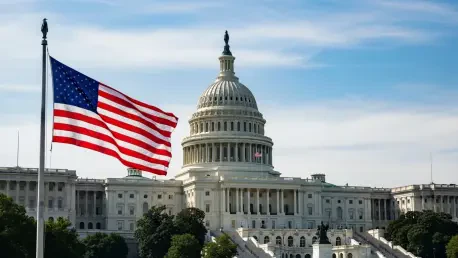In 1980, a single day of closure at the Federal Trade Commission (FTC) sent shockwaves through the fabric of American governance, marking the first time a federal agency halted operations due to a funding lapse, and unveiling vulnerabilities in federal funding mechanisms. This seemingly minor event—lasting just 24 hours—introduced a precedent for political brinkmanship that continues to disrupt government functions. This roundup gathers insights, historical perspectives, and expert analyses from various sources to explore how this pivotal moment reshaped the landscape of U.S. government operations. By examining diverse viewpoints, the discussion aims to uncover the lasting impacts and ongoing relevance of that historic shutdown.
Setting the Scene: The 1980 Government Halt
Before 1980, federal agencies operated under an unspoken assumption that Congress would ensure continuity even during budget delays. Historical accounts note that agencies often carried on with routine functions, confident that funding would eventually be secured. This practice, while not legally codified, had sustained government operations through numerous fiscal hiccups, maintaining a sense of stability across administrations.
The abrupt closure of the FTC on April 30, 1980, shattered this long-standing norm, exposing the fragility of such assumptions. Analysts from legal and historical backgrounds highlight this event as a turning point, emphasizing how a one-day shutdown became a symbol of deeper systemic issues. It forced a reckoning with the legal boundaries of federal spending and set the stage for future disruptions.
The ripple effects of this moment are still felt in modern governance, as funding lapses have become a recurring challenge. Various perspectives point to this incident as the genesis of a new era, where political strategy and legal constraints collide. The journey from a single agency’s closure to today’s complex shutdown protocols offers critical lessons for policymakers and citizens alike.
Unpacking the 1980 FTC Shutdown Crisis
Civiletti’s Antideficiency Act Ruling: A Legal Shift
In early 1980, a landmark legal opinion by Attorney General Benjamin Civiletti redefined the rules of federal funding. Interpreting the 1884 Antideficiency Act, this ruling declared that operating without appropriated funds was a direct violation of law. Legal scholars argue that this interpretation closed a loophole agencies had relied upon for decades, fundamentally altering the operational landscape.
The decision faced immediate scrutiny from government officials who viewed it as overly restrictive. Many expressed concern that such a rigid stance could paralyze essential services during even brief funding gaps. Archival analyses reveal heated debates in Congress over whether this legal shift prioritized fiscal discipline over practical governance.
This ruling laid the groundwork for the FTC’s unprecedented closure, marking the first real-world test of the new legal framework. Historians note that it shifted the burden of responsibility onto lawmakers to avoid lapses, a dynamic that continues to fuel political tensions. The long-term impact of this opinion remains a focal point in discussions about federal budgeting practices.
Chaos in a Day: The FTC’s Historic Closure
On April 30, 1980, the FTC became the first federal agency to shut down due to a lack of funds, furloughing nearly 1,600 employees. This drastic step stemmed from a delayed appropriations cycle compounded by congressional disputes over the agency’s regulatory scope. Historical records paint a vivid picture of federal marshals securing offices while hearings and critical work ground to a halt.
The political undercurrents of this event were stark, with some lawmakers intentionally stalling funds to curb the FTC’s authority over businesses. Commentary from the era reflects a mix of frustration and disbelief at the shutdown’s abruptness, with agency leaders decrying the waste of resources. Emergency funding resolved the crisis within 24 hours, but the precedent was set.
This brief closure revealed the vulnerability of federal agencies to political maneuvering. Observers at the time noted that the incident underscored a need for clearer funding mechanisms to prevent such disruptions. It also highlighted how quickly operational halts could erode public confidence in government efficiency.
Adapting Rules: From Strict Halts to Essential Exemptions
Post-1980, shutdown protocols evolved significantly, moving from near-total closures to allowing exemptions for critical functions. Early policies offered little leeway, but over time, guidelines expanded to protect roles deemed essential for public safety and welfare. Current FTC plans, for instance, span detailed documents outlining which operations must persist during lapses.
Today, over 400 FTC employees are exempt from furloughs, including those handling consumer protection and corporate mergers. Policy experts suggest this shift reflects a pragmatic acknowledgment that certain services cannot be paused without causing immediate harm. However, some argue these exemptions only address symptoms rather than root causes of funding disputes.
The question remains whether such adaptations suffice to mitigate shutdown risks. Analysts point out that while exemptions preserve key functions, they do little to prevent the broader uncertainty faced by federal workers. This ongoing tension continues to spark debate about the adequacy of current contingency measures.
Political Leverage: Shutdowns as a Governance Weapon
The 1980 FTC closure introduced shutdowns as a tool for political negotiation, a tactic that has since grown in frequency and duration. What started as a one-day halt evolved into multi-week standoffs in later decades, often used to pressure opposing sides in budgetary battles. Political historians view this as a direct legacy of the initial precedent.
Differing perspectives emerge on this trend, with some seeing shutdowns as a necessary check on fiscal irresponsibility, while others decry them as reckless posturing. Agency leaders from the 1980 era expressed exasperation at the disruptions, a sentiment echoed by modern federal employees during extended closures. The contrast between past and present attitudes reveals a growing acceptance of shutdowns as a political norm.
Looking ahead, there is speculation about how this strategy might further impact public trust in government stability. Some policy watchers warn that repeated use of shutdowns risks normalizing instability, while others believe it could push lawmakers toward more sustainable funding solutions. This duality shapes ongoing discussions about the role of such tactics in governance.
Key Takeaways from the FTC Shutdown
The 1980 FTC shutdown, catalyzed by a transformative legal opinion, normalized operational halts as a political mechanism, a shift that endures in today’s governance challenges. Historical analyses consistently point to this event as the origin of modern shutdown culture, reshaping how federal agencies navigate funding uncertainties. Diverse sources agree that the incident exposed critical flaws in budgetary processes that persist unresolved.
For policymakers, a key lesson lies in the importance of contingency planning to safeguard essential services during fiscal disputes. Experts in public administration advocate for mechanisms that prioritize funding stability over partisan gridlock, suggesting reforms to appropriations cycles. These practical steps could reduce the risk of disruptions that affect both workers and public services.
Another insight focuses on public advocacy, encouraging citizens to push for legislative changes that address systemic funding issues. Discussions among civic groups emphasize the value of transparency in budget negotiations to prevent sudden halts. Engaging with these ideas offers a pathway to mitigate the recurring cycle of shutdowns that trace back to that single day in 1980.
Reflecting on a Lasting Impact
Looking back, the 1980 FTC shutdown stood as a cautionary tale of how a fleeting operational halt could redefine government functionality for generations. The event, though brief, etched a permanent mark on federal operations, proving that legal rulings and political disputes could intersect with profound consequences. It was a moment that shifted perceptions of government reliability among the public and officials alike.
The enduring challenge lies in breaking the cycle of shutdowns that originated from this incident. Moving forward, actionable steps include advocating for bipartisan agreements on funding timelines to prevent lapses. Exploring innovative fiscal policies that prioritize continuity over conflict could offer a sustainable solution.
Additionally, fostering dialogue between lawmakers and agencies might pave the way for frameworks that minimize political leverage in budgeting. As history has shown, small events can yield outsized impacts, and addressing these issues now could prevent further erosion of trust in governance. Taking these steps ensures that the lessons of 1980 continue to inform a more resilient future.









